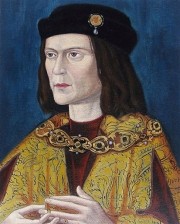Scientists find remains of England’s Richard III under carpark

Undated photo made available by the University of Leicester, England, Monday Feb. 4 2013, of remains found underneath a car park last September at the Grey Friars excavation in Leicester, which have been declared Monday “beyond reasonable doubt” to be the long lost remains of England’s King Richard III, missing for 500 years. AP PHOTO/ UNIVERSITY OF LEICESTER
LEICESTER, United Kingdom—A skeleton found under a carpark in the English city of Leicester was confirmed Monday as that of King Richard III, widely depicted as one of history’s most notorious villains.
Scientists from the University of Leicester matched DNA from the 500-year-old skeleton with that of descendants of the king’s sister, while the skeleton had the twisted spine and battle injuries consistent with contemporary accounts.
“It is the academic conclusion of the University of Leicester that, beyond reasonable doubt, the individual exhumed at Greyfriars in September 2012 is indeed Richard III, the last Plantagenet king of England,” lead archaeologist Richard Buckley said to applause at a press conference at the university.
He said the king’s remains would now be re-interred at Leicester Cathedral, just across from the municipal carpark where they were found, in keeping with archaeological practice to bury remains on the nearest consecrated ground.
The discovery has caused huge excitement among historians, as it provides firm evidence about a monarch whose life has been shrouded in controversy since his death at the Battle of Bosworth in 1485.
Article continues after this advertisementAccording to historical accounts, Richard’s body was transported naked and bloody on the back of a pack horse to Leicester before being buried in an unmarked grave at Greyfriars, a Franciscan friary in the central English city.
Article continues after this advertisementPainted as hunchbacked villain
The crown passed to the Tudor monarchs who, with the help of William Shakespeare, painted Richard as a hunchbacked villain who stopped at nothing in his quest for power, even murdering his two young nephews to secure the throne.
The skeleton confirms that the monarch had severe scoliosis, or twisting of the spine. It may have been painful and caused his right shoulder to appear higher than his left, but there was no evidence of the withered arm depicted in Shakespeare’s “Richard III.”
In a forensic search that at times resembled a television crime drama, and which even one of its supporters admitted was a “one-in-a-million shot,” the evidence that the remains belonged to Richard quickly stacked up.

Michael Ibsen, a descendant of England’s King Richard III, from whom DNA samples were taken, listens during a press conference Monday Feb. 4, 2013, at the University of Leicester Council Chamber building, regarding the exhumation of the remains found during a dig at a Leicester car park. AP PHOTO/RUI VIEIRA
The man was the right age—Richard died aged 32—had a high-protein diet consistent with someone of high birth, and had a slender, almost feminine build, which matched contemporary accounts.
Carbon dating put the skeleton in Richard’s era, while it also showed clear signs of having been in battle.
It had two significant wounds to the skull, likely caused by a sword and a halberd, a type of axe, one of which killed him, according to Jo Appleby, the project’s lead osteologist.
‘Humiliation injuries’
There was also evidence of “humiliation injuries” to the face and buttocks, which may well have been inflicted on his naked body by rivals after his death.
The researchers were confident they had found Richard, but the final confirmation only came with the DNA results on Sunday, just hours before more than 150 journalists were due to gather for the announcement.
Geneticist Turi King had confirmed that the skeleton’s DNA matched that of two descendants of Richard’s sister, Anne of York—a Canadian-born carpenter, Michael Ibsen, and another person who wishes to remain anonymous.
“In short the DNA evidence points to these being the remains of Richard III,” she told the press conference.
Ibsen, a 17th-generation descendant, told AFP he was “stunned” by the discovery and said he was looking forward to seeing the facial reconstruction of Richard, although he added: “It won’t look like me.”
Historians now hope to dispel some of the myths about Richard, publicizing evidence to refute claims that he killed his nephews, the so-called Princes in the Tower, and focusing on what he achieved in his brief two-year reign, including the establishment of a system of bail and legal aid.
Related to Queen Elizabeth II
His rule was challenged, and he was defeated and killed by the army of Henry Tudor, who took the throne as King Henry VII and ended the Plantagenet line. (Britain’s current monarch, Queen Elizabeth II, is distantly related to Richard, but is not a descendant.)
Philippa Langley, a member of the Richard III Society who coordinated and helped fund the search, said she hoped a new image would emerge of the king and “the two-dimensional character devised by the Tudors will be no more.”
“We have searched for Richard and we have found him. Now it’s time to honor him,” she said.
Lin Foxhall, head of the university’s school of archaeology, said the discovery “could end up rewriting a little bit of history in a big way.”
Few monarchs have seen their reputations decline as much after death as Richard III. He ruled England between 1483 and 1485, during the decades-long tussle over the throne known as the Wars of the Roses, which pitted two wings of the ruling Plantagenet dynasty — York and Lancaster — against one another.
The location of Richard’s body was unknown for centuries. He died in August 1485 at the Battle of Bosworth Field in the English Midlands, and records say he was buried by the Franciscan monks of Grey Friars at their church in Leicester, 100 miles (160 kilometers) north of London.
The church was closed and dismantled after King Henry VIII dissolved the monasteries in 1538, and its location eventually was forgotten by most local residents.
There were tales that the king’s bones had been dug up and thrown in a nearby river in the 16th century.
But last year a team led by University of Leicester archaeologist Richard Buckley identified a possible location of the grave through map regression analysis, starting with a current map of the general area of the former church and analyzing earlier maps to discover what had changed and not changed. Ground-penetrating radar was used to find the best places to start digging.
The team began excavating in a parking lot last August. Within a week they had located thick walls and the remains of tiled floors. Soon after, they found human remains—the skeleton of an adult male who appeared to have died in battle.
Buried unceremoniously
He had been buried unceremoniously, with no coffin or shroud—plausible for a despised and defeated enemy.
Increasingly excited, the researchers set out to conduct a battery of scientific tests, including radiocarbon dating to determine the skeleton’s age, to see whether, against the odds, they really had found the king.

Undated photo made available by the University of Leicester, England, Monday Feb. 4, 2013, of the earliest surviving portrait of Richard III in Leicester Cathedral, ahead of an announcement about the identity of the skeleton found underneath a car park last September. AP PHOTO/ UNIVERSITY OF LEICESTER
They found the skeleton belonged to a man aged between his late 20s and late 30s who died between 1455 and 1540. Richard was 32 when he died in 1485.
Archaeological bone specialist Jo Appleby, a lecturer in human bioarchaeology at Leicester, said study of the bones provided “a highly convincing case for identification of Richard III.”
Appleby said the 10 injuries to the body were inflicted by weapons such as swords, daggers and halberds and were consistent with accounts of Richard being struck down in battle — his helmet knocked from his head — before his body was stripped naked and flung over the back of a horse in disgrace.
Appleby said two of the blows to the head could have been fatal. Some other scars, including a knife wound to the buttock, bore the hallmarks of “humiliation injuries” inflicted after death.
On Monday, the king’s skeleton lay in a glass box in a meeting room within the university library. It was a browned, fragile-looking thing, its skull pocked with injuries, missing its feet—which scientists say were disturbed sometime after burial—and with a pronounced s-shape to the spine.
Soon the remains will be moved to an undisclosed secure location, and next year Richard will, at last, get a king’s burial, interred with pomp and ceremony in Leicester Cathedral.
It is a day Langley, of the Richard III Society, has dreamed of seeing.
“We have searched for him, we have found him — it is now time to honor him,” she said.